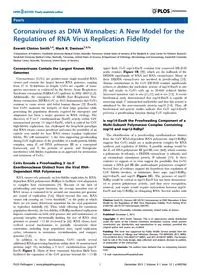
2013 Coronaviruses as DNA Wannabes_ A New Model for the Regulation of RNA Virus Replication Fidelity PDF
Preview 2013 Coronaviruses as DNA Wannabes_ A New Model for the Regulation of RNA Virus Replication Fidelity
Pearls Coronaviruses as DNA Wannabes: A New Model for the Regulation of RNA Virus Replication Fidelity Everett Clinton Smith1,2, Mark R. Denison1,2,3* 1 Department of Pediatrics, Vanderbilt University Medical Center, Nashville, Tennessee, United States of America, 2 The Elizabeth B. Lamb Center for Pediatric Research, Vanderbilt University Medical Center, Nashville, Tennessee, United States of America, 3 Department of Pathology, Microbiology and Immunology, Vanderbilt University Medical Center, Nashville, Tennessee, United States of America Coronaviruses Contain the Largest Known RNA Genomes Coronaviruses (CoVs) are positive-sense single-stranded RNA viruses and contain the largest known RNA genomes, ranging from 27 to 32 kilobases in length. CoVs are capable of trans- species movement as evidenced by the Severe Acute Respiratory Syndrome coronavirus (SARS-CoV) epidemic in 2002–2003 [1,2]. Additionally, the emergence of Middle East Respiratory Syn- drome coronavirus (MERS-CoV) in 2012 demonstrates that CoVs continue to cause severe and lethal human disease [3]. Exactly how CoVs maintain the integrity of their large genomes while generating the population diversity required for emergence and adaptation has been a major question in RNA virology. The discovery of 39-to-59 exoribonuclease (ExoN) activity within CoV nonstructural protein 14 (nsp14-ExoN), which is critical for CoV high-fidelity replication, has challenged the long-held paradigm that RNA viruses cannot proofread and raises the possibility of an entirely new model for how RNA viruses regulate replication fidelity. We will summarize: 1) the data supporting proofreading during CoV replication; 2) the possibility of a multi-protein fidelity complex, using E. coli DNA polymerase III as a conceptual framework; and 3) the promise of genetic and therapeutic interference with fidelity regulation as an approach for attenuation and treatment of CoVs. CoVs Encode a Proofreading 39-to-59 Exoribonuclease Distinct from the Viral RNA- Dependent RNA Polymerase RNA viruses rely primarily on low-fidelity replication by RNA- dependent RNA polymerases (RdRps) to facilitate viral adaptation to complex host environments [4]. Because of the lack of proofreading and repair functions, the average mutation rate of RNA viruses is estimated to be around one mutation per genome per round of replication [5,6]. Much beyond this rate, RNA viruses risk crossing an ‘‘error threshold,’’ or the point at which there are too many deleterious mutations for the viral population to reproduce faithfully [4]. Thus, while allowing for enormous population diversity, the low-fidelity of RdRp-mediated replication imposes constraints on both viral genome size and maintenance of genomic integrity, theoretically limiting the size of RNA virus genomes to around ,15 kb (reviewed in [4]). RNA viruses have evolved several mechanisms to partially circumvent these constraints, including large population sizes, rapid replication cycles, robustness to mutations, recombination, and compact genomes [7,8]. In addition to these mechanisms, CoVs encode several additional RNA-processing functions within their 16 nonstructural proteins (nsp1–16), including a 39-to-59 exoribonuclease (nsp14- ExoN; Figure 1). Many of these enzymatic functions likely have facilitated the expansion of the CoV genome beyond the ,15 kb upper limit. CoV nsp14-ExoN contains four conserved DE-D-D acidic residues (Figure 1B; [9]), which are the hallmark of the DEDDh superfamily of DNA and RNA exonucleases. Many of these DEDDh exonucleases are involved in proofreading [10]. Alanine substitutions at the CoV DE-D-D residues significantly reduces or abolishes the nucleolytic activity of nsp14-ExoN in vitro [9] and results in CoVs with up to 20-fold reduced fidelity (increased mutation rate) in vitro [11,12] and in vivo [13]. A recent biochemical study demonstrated that nsp14-ExoN is capable of removing single 39 mismatched nucleotides and that this activity is stimulated by the non-enzymatic protein nsp10 [14]. Thus, all biochemical and genetic studies indicate that CoV nsp14-ExoN performs a proofreading function during CoV replication. Is nsp14-ExoN the Proofreading Component of a Multi-Subunit Polymerase Complex Containing nsp10 and nsp12-RdRp? The identification of a proofreading exoribonuclease distinct from the CoV RNA-dependent RNA polymerase (nsp12-RdRp) suggests that CoVs might use a multi-protein complex for RNA synthesis and regulation of fidelity. A possible analogy would be the E. coli DNA polymerase III (pol III) core (aeh), which contains a polymerase (a subunit), a DEDDh exonuclease (e subunit), and an exonuclease stimulatory protein (h subunit) [15]. Is there evidence to support or to even suggest the possibility that CoVs contain a DNA pol III–like multi-subunit polymerase complex? Several lines of evidence support the hypothesis that regulation of CoV fidelity involves, at minimum, three nsps: nsp12-RdRp, nsp14-ExoN, and nsp10 (Figure 1C). The presence of nsp12- RdRp would be critical as nsp14-ExoN has not been demonstrat- ed to possess polymerase activity, and thus error recognition, removal, and repair would require interactions between nsp14- ExoN and nsp12-RdRp on elongating RNA. Several studies with Citation: Smith EC, Denison MR (2013) Coronaviruses as DNA Wannabes: A New Model for the Regulation of RNA Virus Replication Fidelity. PLoS Pathog 9(12): e1003760. doi:10.1371/journal.ppat.1003760 Editor: Vincent Racaniello, Columbia University, United States of Amrica Published December 5, 2013 Copyright: � 2013 Smith, Denison. This is an open-access article distributed under the terms of the Creative Commons Attribution License, which permits unrestricted use, distribution, and reproduction in any medium, provided the original author and source are credited. Funding: This work was supported by Public Health Service awards from the National Institute of Allergy and Infectious Diseases T32-AI095202 (ECS, MRD), F32-AI108102 (ECS), U54-AI057157 (MRD), and RO1-AI108197 (MRD). The funders had no role in the study design, data collection and analysis, decision to publish, or preparation of the manuscript. Competing Interests: The authors have declared that no competing interests exist. * E-mail:
